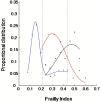Mortality in Relation to Frailty in Patients Admitted to a Specialized Geriatric Intensive Care Unit
- PMID: 26400736
- PMCID: PMC4631107
- DOI: 10.1093/gerona/glv084
Mortality in Relation to Frailty in Patients Admitted to a Specialized Geriatric Intensive Care Unit
Abstract
Background: In older adults admitted to intensive care units (ICUs), frailty influences prognosis. We examined the relationship between the frailty index (FI) based on deficit accumulation and early and late survival.
Methods: Older patients (≥65 years) admitted to a specialized geriatric ICU at the Liuhuaqiao Hospital, Guangzhou, China between July-December 2011 (n = 155; age 82.7±7.1 y; 87.1% men) were followed for 300 days. The FI was calculated as the proportion present of 52 health deficits. FI performance was compared with that of several prognostic scores.
Results: The 90-day death rate was 38.7% (n = 60; 27 died within 30 days). The FI score was correlated with the Glasgow Coma Scale, Karnofsky Scale, Palliative Performance Scale, Acute Physiology Score-APACHE II and APACHE IV (r (2) = 0.52 to 0.72, p < 0.001). Patients who died within 30 days had higher mean FI scores (0.41±0.11) than those who survived to 300 days (0.22±0.11; F = 38.91, p < 0.001). Each 1% increase in the FI from the previous level was associated with an 11% increase in the 30-day mortality risk (95% CI: 7%-15%) adjusting for age, sex, and the prognostic scores. The FI discriminated patients who died in 30 days from those who survived with moderately high accuracy (AUC = 0.89±0.03). No one with an FI score >0.46 survived past 90 days.
Conclusion: ICU survival was strongly associated with the level of frailty at admission. An FI based on health deficit accumulation may help improve critical care outcome prediction in older adults.
Keywords: Frailty; Frailty index; Older patients; Specialized geriatric intensive care unit; Survival.
© The Author 2015. Published by Oxford University Press on behalf of The Gerontological Society of America.
Figures


Similar articles
-
The risk of adverse outcomes in hospitalized older patients in relation to a frailty index based on a comprehensive geriatric assessment.Age Ageing. 2014 Jan;43(1):127-32. doi: 10.1093/ageing/aft156. Epub 2013 Oct 30. Age Ageing. 2014. PMID: 24171946
-
Is frailty a prognostic factor for critically ill elderly patients?Aging Clin Exp Res. 2017 Apr;29(2):247-255. doi: 10.1007/s40520-016-0557-y. Epub 2016 Mar 22. Aging Clin Exp Res. 2017. PMID: 27002968
-
Superiority of frailty over age in predicting outcomes among geriatric trauma patients: a prospective analysis.JAMA Surg. 2014 Aug;149(8):766-72. doi: 10.1001/jamasurg.2014.296. JAMA Surg. 2014. PMID: 24920308
-
The frailty index based on laboratory test data as a tool to investigate the impact of frailty on health outcomes: a systematic review and meta-analysis.Age Ageing. 2023 Jan 8;52(1):afac309. doi: 10.1093/ageing/afac309. Age Ageing. 2023. PMID: 36626319 Free PMC article.
-
Frailty and the Association Between Long-Term Recovery After Intensive Care Unit Admission.Crit Care Clin. 2018 Oct;34(4):527-547. doi: 10.1016/j.ccc.2018.06.007. Epub 2018 Aug 11. Crit Care Clin. 2018. PMID: 30223992 Review.
Cited by
-
Survival Curves and Behavioral Profiles of Female 3xTg-AD Mice Surviving to 18-Months of Age as Compared to Mice with Normal Aging.J Alzheimers Dis Rep. 2017 Jul 6;1(1):47-57. doi: 10.3233/ADR-170011. J Alzheimers Dis Rep. 2017. PMID: 30480229 Free PMC article.
-
Frailty assessed by administrative tools and mortality in patients with pneumonia admitted to the hospital and ICU in Wales.Sci Rep. 2021 Jun 28;11(1):13407. doi: 10.1038/s41598-021-92874-w. Sci Rep. 2021. PMID: 34183745 Free PMC article.
-
Genotype Load Modulates Amyloid Burden and Anxiety-Like Patterns in Male 3xTg-AD Survivors despite Similar Neuro-Immunoendocrine, Synaptic and Cognitive Impairments.Biomedicines. 2021 Jun 23;9(7):715. doi: 10.3390/biomedicines9070715. Biomedicines. 2021. PMID: 34201608 Free PMC article.
-
Pre-Frailty Increases the Risk of Adverse Events in Older Patients Undergoing Cardiovascular Surgery.Arq Bras Cardiol. 2017 Oct;109(4):299-306. doi: 10.5935/abc.20170131. Epub 2017 Sep 4. Arq Bras Cardiol. 2017. PMID: 28876376 Free PMC article.
-
The impact of frailty on intensive care unit outcomes: a systematic review and meta-analysis.Intensive Care Med. 2017 Aug;43(8):1105-1122. doi: 10.1007/s00134-017-4867-0. Epub 2017 Jul 4. Intensive Care Med. 2017. PMID: 28676896 Free PMC article.
References
-
- Rockwood K, Mitnitski A. Frailty defined by deficit accumulation and geriatric medicine defined by frailty. Clin Geriatr Med. 2011;27:17–26. doi:10.1016/j.cger.2010.08.008 - PubMed
-
- Vaupel JW, Manton KG, Stallard E. The impact of heterogeneity in individual frailty on the dynamics of mortality. Demography. 1979;16:439–454. doi:10.2307/2061224 - PubMed
-
- Fried LP, Tangen CM, Walston J, et al. Frailty in older adults: evidence for a phenotype. J Gerontol A Biol Sci Med Sci. 2001;56:M146–M156. doi:10.1093/Gerona/56.3.M146 - PubMed
Publication types
MeSH terms
Grants and funding
LinkOut - more resources
Full Text Sources
Other Literature Sources
Miscellaneous

